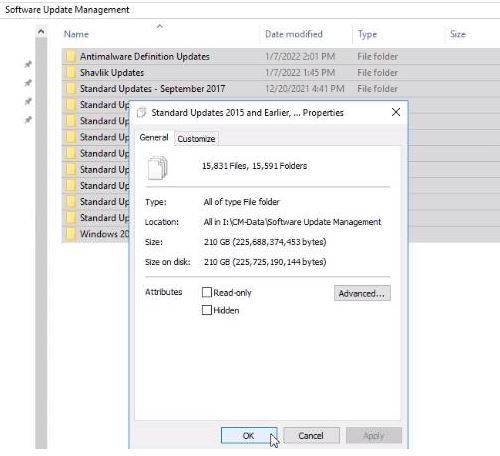In general, I would never specifically delete anything from the source folders as these should correspond to an update downloaded and most likely deployed in the console thus delete the source file could break the deployment (assuming the package gets updated at some point as well). If they need or want to reclaim disk space, then they need to clean up the deployed updates in the console first although really, adding disk space is advisable here also because as noted, 210GB is not all that miuch.
MECM Updates Source directory clean up
I have seen this asked in the past and I have seen use of the contentclean script to clean expired updates from Software update groups that are not automatically getting cleaned up.
I have instances where a SUG is created for a year end wrap up (eg Updates 2015 and earlier) and have been distributed to the DPs. Can I simply remove the source folders for the older year(s) SUGs since they should not be updated anymore or do I need to keep them around on the primary?
I am just trying to reclaim disk space...
Microsoft Security | Intune | Configuration Manager | Other
-
 Jason Sandys 31,406 Reputation points Microsoft Employee Moderator
Jason Sandys 31,406 Reputation points Microsoft Employee Moderator2022-01-20T20:23:15.947+00:00
5 additional answers
Sort by: Most helpful
-
 Rahul Jindal [MVP] 10,911 Reputation points MVP
Rahul Jindal [MVP] 10,911 Reputation points MVP2022-01-19T21:55:23.51+00:00 Try to stick to supported out of the box solutions as much as possible. Enable Wsus maintenance in SUP component properties. Expire superseded feature and security updates after 1-2 months. All superseded and expired updates will get cleaned up on next scheduled sync.
-
 Jason Sandys 31,406 Reputation points Microsoft Employee Moderator
Jason Sandys 31,406 Reputation points Microsoft Employee Moderator2022-01-19T22:53:50.34+00:00 Plus one to Rahul's answers (although one correction that only undeployed expired updates get cleaned up -- undeployed superseded updates get expired). See the official docs at https://learn.microsoft.com/en-us/mem/configmgr/sum/deploy-use/software-updates-maintenance for lots of details.
Also, keep in mind that update groups have no source files. Update packages have source files. They are not the same.
-
Michael Pawlak 21 Reputation points
2022-01-20T01:02:49.21+00:00 Thank you for the article and correction on SUG and packages. Indeed this is related to the size of the source locations for the update packages. I believe that the client likes to keep the older updates as a catch up for devices that are put online in the environment, thus I assume that there a lot of expired updates that just didn't get cleaned up from the source directory. (for one reason or another).
I just wonder if they are "stuck" with these large yearly package sources until they decide to remove the deployments if there is not an easy way to clean them up.
-
 Jason Sandys 31,406 Reputation points Microsoft Employee Moderator
Jason Sandys 31,406 Reputation points Microsoft Employee Moderator2022-01-20T17:49:58.813+00:00 Without an in-depth review, I can't say anything for sure. The clean-up process does clean up source folders when cleaning up expired updates though unless the updates are still deployed. Thus, the question here shifts to cleaning up their update groups and whether that's been done to ensure that expired updates are no longer deployed.
Also, given the size of updates, 210 GB is not actually all that much.